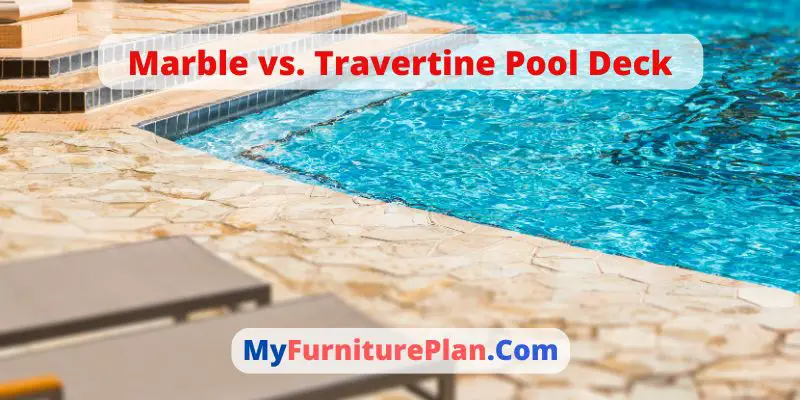Introduction
The choice of material for your pool deck matters. It not only influences the aesthetics and functionality of your outdoor space but also significantly impacts maintenance, durability, and cost over time. Among the popular options, natural stone surfaces such as marble and travertine stand out for their timeless appeal and impressive performance. But how do you decide which one suits your needs better? Let’s dive into the world of marble and travertine pool decks to help you make an informed decision.
Marble Pool Decks:
Characteristics and Benefits
Marble exudes luxury and elegance, making it a top choice for high-end pool designs. Its smooth surface and cool touch underfoot are particularly appealing during hot summer months.
Alex Johnson, a renowned landscape architect, says, “Marble’s luxurious appeal and cool touch make it a top choice for high-end pool designs.”
Maintenance, Durability, and Cost
While marble is durable, it is also porous, making it susceptible to staining and etching if not properly sealed and maintained. Regular sealing can help maintain its pristine appearance but adds to the upkeep.
From a cost perspective, marble tends to be on the higher end, reflecting its premium qualities.
Design Options and Aesthetic Appeal
Marble comes in various colors and patterns, allowing for a high degree of customization. Its natural veining can add a unique, artistic element to your pool deck, making each installation one-of-a-kind.
Travertine Pool Decks:
Unique Qualities
Travertine offers a distinct set of benefits, including its naturally porous texture, which provides enhanced grip—an important safety feature for pool decks. It also remains cool to the touch, even under direct sunlight, making it comfortable for bare feet.
Sarah Lee, Director of Pools & Spas Magazine, notes, “Travertine’s natural porous texture offers enhanced safety and comfort underfoot, making it ideal for family pools.”
Maintenance, Durability, and Cost Comparison with Marble
Travertine is also a durable material but generally requires less maintenance than marble. It is less prone to staining and doesn’t need sealing as frequently. In terms of cost, travertine often comes at a more affordable price point compared to marble, making it an attractive option for many homeowners.
Aesthetic Versatility and Design Options
Travertine offers a diverse range of color options, from creamy whites to rich browns, allowing for versatile design choices. Its natural, earthy appearance can complement various landscaping styles, from modern to rustic.
Factors for Decision Making:
Practical Considerations
When choosing between marble and travertine, consider your local climate, pool usage, and budget. Marble is excellent for hot climates due to its cooling properties but may require more maintenance if your pool area is prone to heavy use or exposure to harsh elements. Travertine, with its enhanced grip and lower maintenance needs, might be more suitable for family pools or areas with variable weather conditions.
Environmental Impact and Sustainability
Sustainability is another vital factor. Quarrying and processing natural stone can have significant environmental impacts. Data from the U.S. Geological Survey shows that both marble and travertine quarrying involve similar processes, but the environmental footprint can vary based on the specific quarrying practices and locations.
Pros and Cons:
Pros of Marble Pool Decks
- Luxurious Appearance: Marble provides a high-end, sophisticated look that elevates the overall aesthetic of any pool area.
- Cooling Properties: The stone remains cool underfoot even in hot weather, adding comfort for users.
- Unique Patterns: The natural veining of marble offers unique and artistic patterns, ensuring that no two installations look the same.
Cons of Marble Pool Decks
- High Maintenance: Marble requires regular sealing and maintenance to avoid staining and etching, which can be time-consuming and costly.
- Slippery Surface: When wet, marble can become quite slippery, potentially posing a safety hazard.
- Higher Cost: Marble is generally more expensive compared to other materials like travertine, which can be a significant factor for budget-conscious homeowners.
Pros of Travertine Pool Decks
- Enhanced Safety: The naturally porous texture of travertine provides excellent grip, reducing the risk of slipping—especially important for family pools.
- Low Maintenance: Travertine is less prone to staining and generally requires less maintenance than marble, making it a more convenient option.
- Affordability: Travertine tends to be more affordable than marble, offering a cost-effective solution without compromising on quality and aesthetics.
Cons of Travertine Pool Decks
- Potential Pitting: The natural pores of travertine can sometimes develop pits over time, which may require filling or additional maintenance.
- Limited Color Range: While travertine comes in various earthy tones, it does not offer the same wide range of colors and patterns that marble provides.
- Temperature Sensitivity: Although travertine remains relatively cool, it can sometimes feel warmer underfoot compared to marble, especially in extremely hot climates.
By weighing these pros and cons, you can better determine which material will best meet your needs and preferences for a pool deck that complements your lifestyle.
Installation Cost:
Marble Pool Decks
Installing a marble pool deck is generally more costly due to several factors. First, the material itself is premium-priced, reflecting its luxurious appearance and high-end qualities. Second, the installation process can be labor-intensive, requiring skilled craftsmen to ensure each slab is properly laid and sealed to prevent future issues like staining or etching. According to various industry reports, the total cost for installing a marble pool deck can range from $15 to $50 per square foot, depending on the specific type of marble and the complexity of the design.
Travertine Pool Decks
Travertine, while still considered a high-quality material, often comes at a lower price point compared to marble. This makes it a more budget-friendly option for homeowners looking to achieve a sophisticated look without breaking the bank. The installation process for travertine is usually simpler, though it still requires attention to detail to manage the material’s natural pores and prevent potential pitting. Typically, the cost to install a travertine pool deck ranges from $10 to $30 per square foot. This affordability, combined with its low maintenance needs, makes travertine a cost-effective choice.
Maintenance Tips for Marble and Travertine Pool Decks:
Marble Pool Deck Maintenance Tips
- Regular Sealing: Due to its porous nature, marble requires regular sealing to prevent staining and etching. It is advisable to seal your marble pool deck annually or bi-annually, depending on the level of usage and exposure to the elements.
- Cleaning Spills Promptly: To maintain its pristine appearance, clean spills immediately to avoid permanent staining. Use a soft cloth and a gentle cleanser suitable for marble.
- Avoid Harsh Cleaners: Steer clear of acidic or abrasive cleaners, which can damage the marble surface. Opt for pH-neutral cleaning solutions specifically designed for natural stone.
- Protective Measures: Place mats or rugs in high-traffic areas to provide an additional layer of protection. Additionally, use coasters and trays under furniture or poolside accessories to prevent scratches and stains.
- Periodic Polishing: To retain its luxurious shine, consider periodic professional polishing. This process can restore the marble’s gloss and remove minor surface imperfections.
Travertine Pool Deck Maintenance Tips
- Sealing: While travertine is less prone to staining than marble, it still benefits from periodic sealing. Apply a high-quality sealer every two to three years to protect the stone from moisture and damage.
- Routine Cleaning: Regularly sweep and wash your travertine deck to keep it free of debris and dirt. Use a soft broom and a mild detergent mixed with water.
- Address Spills Quickly: Although travertine is more forgiving, it’s still important to clean spills quickly. A soft cloth and mild soap should suffice for most spills.
- Avoid Acidic Cleaners: Just like marble, travertine can be damaged by acidic substances. Stick to neutral, stone-safe cleaners to preserve its integrity.
- Professional Maintenance: For optimal longevity and appearance, consider professional deep cleaning and maintenance every few years. This can help address any minor surface wear and tear while revitalising the stone’s natural beauty.
By following these maintenance tips, you can ensure that both marble and travertine pool decks remain a stunning and functional part of your outdoor living space for many years to come.
Case Studies:
Real-Life Examples
To provide a well-rounded perspective, let’s look at some real-life examples of marble and travertine pool deck installations.
Marble Pool Deck
John and Emily Smith chose a marble pool deck for their luxury home in Florida. “We were drawn to the elegance of marble and its ability to stay cool even on the hottest days,” says John. The couple acknowledges the need for regular maintenance but feels the aesthetic payoff is worth it.
Travertine Pool Deck
On the other hand, the Johnson family in California opted for a travertine pool deck. “Safety was our primary concern, and travertine’s natural grip sold us,” explains Mrs. Johnson. The family also appreciates the lower maintenance requirements and the material’s ability to blend seamlessly with their home’s Mediterranean-style architecture.
Testimonials from Homeowners and Pool Professionals
Michael Green, a pool decking specialist, advises, “When considering pool decks, it’s essential to weigh the durability and maintenance needs of materials. Travertine often strikes the perfect balance.”
Conclusion:
Both marble and travertine offer unique benefits that can enhance the beauty and functionality of your pool deck. Marble stands out for its luxurious appeal and cooling touch, while travertine excels in safety, comfort, and cost-effectiveness. Your choice will ultimately depend on your specific needs, preferences, and budget.
By considering factors such as climate, pool usage, and maintenance requirements, you can make an informed decision that ensures your pool deck not only looks stunning but also serves your practical needs for years to come.
For homeowners and pool enthusiasts looking to elevate their outdoor spaces, understanding the nuances between marble and travertine is crucial. As you explore your options, we encourage you to think about what matters most to you and your family.
Ready to transform your pool deck? Whether you choose marble or travertine, you’re investing in a timeless, natural stone that adds beauty and value to your home.
Happy renovating!


